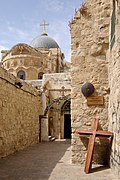Ancient monument
The term ancient monument is a term in British law. It is an early historical structure or monument. For example. it may be an archaeological site worth preserving and study. The sites (monuments) are of archaeological or heritage interest.
The term differs from the American term "national monument". The U.S. National Monuments are few in number and may include natural formations. British ancient monuments are by definition manmade.
Ancient monuments are defined by the Ancient Monuments and Archaeological Areas Act 1979[1] as
- (a) any scheduled monument (there are now more than 20,000)[2] and
- (b) any other monument which in the opinion of the Secretary of State is of public interest for its historic, architectural, traditional, artistic or archaeological interest.
Ancient Monument Media
The Angkor Wat is an ancient temple and heritage site in Cambodia and is a symbol on the notes of Cambodian currency.
The archaeological site of Ancient Olympia in Greece where tourists, particularly archaeologists or students, visit from across the world for different purposes: to examine, study, or view the site.
Pollution in Agra, India impacts the exteriors of the Taj Mahal.
The Western Wall, located in the Jewish quarters of the Old city of Jerusalem, is a religious site for Jewish pilgrims.
The Dome of the Rock, part of the compound known as the Masjid Al-Aqsa, is one of the holiest sites in Islam.
The Church of the Holy Sepulchre is a sacred site for Christians, who believe that it is the place where Jesus was crucified and resurrected and that his tomb is located there.
Related pages
References
- ↑ "Ancient Monuments and Archaeological Areas Act 1979". 4 April 1979. Retrieved 28 February 2012.,
- ↑ "Scheduled Monuments" (PDF). Department for Culture, Media and Sport. March 2010. Archived from the original (PDF) on 2012-12-04. Retrieved 7 June 2011.








